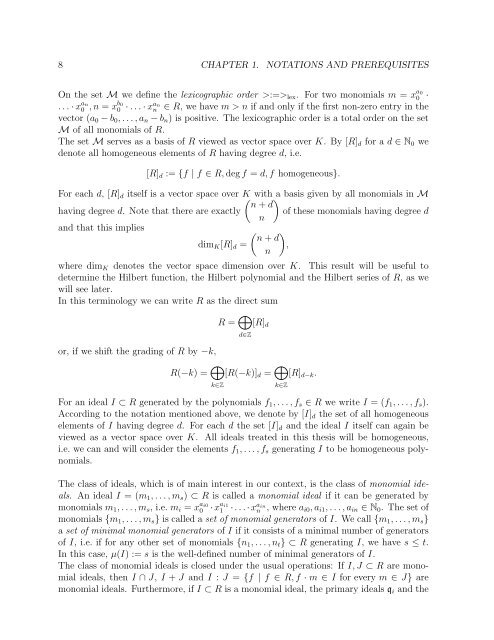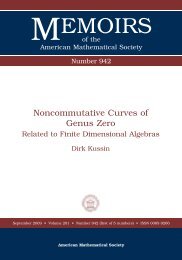University of Paderborn Department of Mathematics Diploma Thesis ...
University of Paderborn Department of Mathematics Diploma Thesis ...
University of Paderborn Department of Mathematics Diploma Thesis ...
Create successful ePaper yourself
Turn your PDF publications into a flip-book with our unique Google optimized e-Paper software.
8 CHAPTER 1. NOTATIONS AND PREREQUISITESOn the set M we define the lexicographic order >:=> lex . For two monomials m = x a 00 ·. . . · x an0 , n = x b 00 · . . . · x ann ∈ R, we have m > n if and only if the first non-zero entry in thevector (a 0 − b 0 , . . . , a n − b n ) is positive. The lexicographic order is a total order on the setM <strong>of</strong> all monomials <strong>of</strong> R.The set M serves as a basis <strong>of</strong> R viewed as vector space over K. By [R] d for a d ∈ N 0 wedenote all homogeneous elements <strong>of</strong> R having degree d, i.e.[R] d := {f | f ∈ R, deg f = d, f homogeneous}.For each d, [R] d itself is a vector space over K( with)a basis given by all monomials in Mn + dhaving degree d. Note that there are exactly <strong>of</strong> these monomials having degree dnand that this implies( ) n + ddim K [R] d = ,nwhere dim K denotes the vector space dimension over K. This result will be useful todetermine the Hilbert function, the Hilbert polynomial and the Hilbert series <strong>of</strong> R, as wewill see later.In this terminology we can write R as the direct sumR = ⊕ d∈Z[R] dor, if we shift the grading <strong>of</strong> R by −k,R(−k) = ⊕ k∈Z[R(−k)] d = ⊕ k∈Z[R] d−k .For an ideal I ⊂ R generated by the polynomials f 1 , . . . , f s ∈ R we write I = (f 1 , . . . , f s ).According to the notation mentioned above, we denote by [I] d the set <strong>of</strong> all homogeneouselements <strong>of</strong> I having degree d. For each d the set [I] d and the ideal I itself can again beviewed as a vector space over K. All ideals treated in this thesis will be homogeneous,i.e. we can and will consider the elements f 1 , . . . , f s generating I to be homogeneous polynomials.The class <strong>of</strong> ideals, which is <strong>of</strong> main interest in our context, is the class <strong>of</strong> monomial ideals.An ideal I = (m 1 , . . . , m s ) ⊂ R is called a monomial ideal if it can be generated bymonomials m 1 , . . . , m s , i.e. m i = x a i00 · x a i11 · . . . · x a inn , where a i0 , a i1 , . . . , a in ∈ N 0 . The set <strong>of</strong>monomials {m 1 , . . . , m s } is called a set <strong>of</strong> monomial generators <strong>of</strong> I. We call {m 1 , . . . , m s }a set <strong>of</strong> minimal monomial generators <strong>of</strong> I if it consists <strong>of</strong> a minimal number <strong>of</strong> generators<strong>of</strong> I, i.e. if for any other set <strong>of</strong> monomials {n 1 , . . . , n t } ⊂ R generating I, we have s ≤ t.In this case, µ(I) := s is the well-defined number <strong>of</strong> minimal generators <strong>of</strong> I.The class <strong>of</strong> monomial ideals is closed under the usual operations: If I, J ⊂ R are monomialideals, then I ∩ J, I + J and I : J = {f | f ∈ R, f · m ∈ I for every m ∈ J} aremonomial ideals. Furthermore, if I ⊂ R is a monomial ideal, the primary ideals q i and the
















